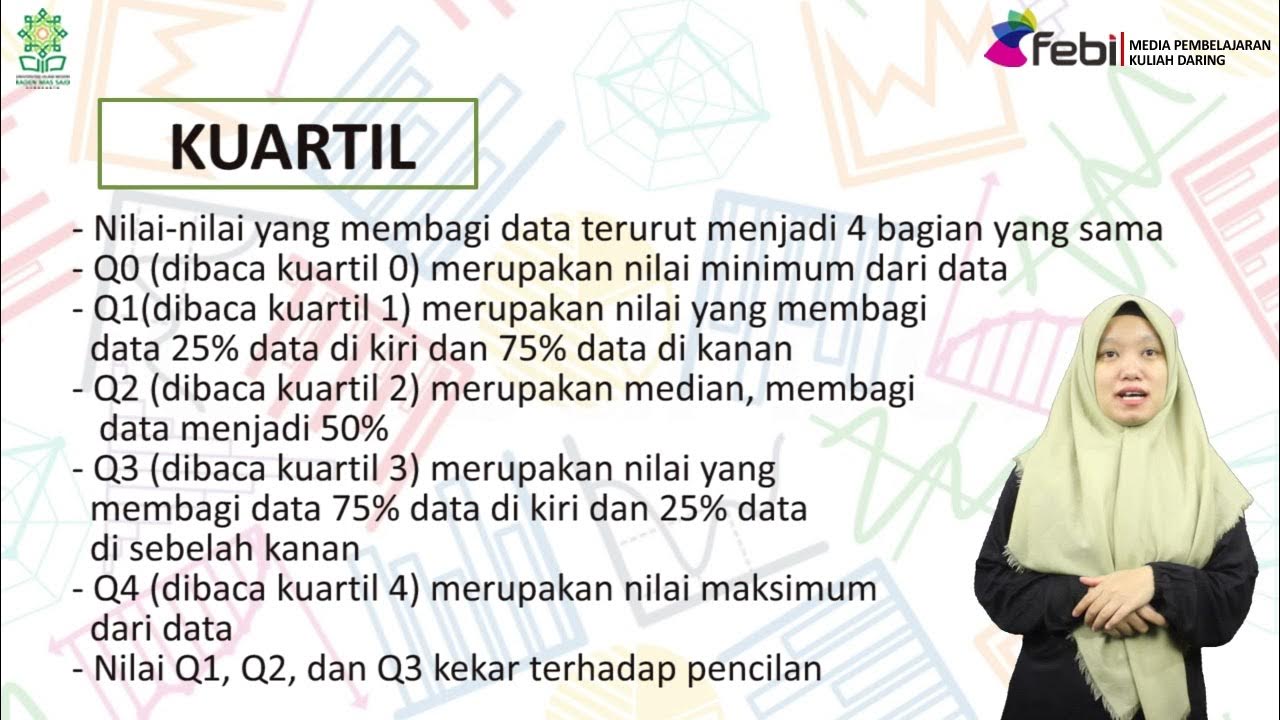Chebyshev's Rule
Summary
TLDRThis script teaches how to understand data distribution through measures of central tendency and dispersion. It explains the relationship between mean and standard deviation, using them to create a scale that helps visualize data distribution. The concept of sigmas is introduced to identify values within one, two, or three standard deviations from the mean. Outliers, defined as observations beyond three standard deviations, are discussed. Chebyshev's Theorem is highlighted, illustrating that at least a certain percentage of data falls within a given number of standard deviations from the mean, regardless of the distribution shape. This allows for a rough visualization of data distribution using just the mean and standard deviation.
Takeaways
- 📊 **Data Distribution Understanding**: We learn to understand data distribution through measures of center and variation, which help in constructing visual summaries when direct visualization is not possible.
- 🔢 **Numerical Summaries**: When visual summaries are not feasible, numerical summaries like mean and standard deviation are used to communicate data concisely and informatively.
- 📈 **Interpreting Numerical Summaries**: The script teaches how to interpret numerical summaries to describe the shape of a data distribution, using the relationship between mean and standard deviation.
- ➕ **Sigma Scale Creation**: By adding and subtracting sigma (standard deviation) from the mean, we create a scale that helps in understanding where data points lie in relation to the mean.
- 🌐 **Standard Deviation Zones**: Data points within one, two, or three standard deviations from the mean are considered to be within specific zones that reflect their proximity to the central tendency.
- 📉 **Outlier Identification**: Outliers are data points that are extreme relative to others, and the three standard deviation rule is a common method to identify them.
- 📚 **Three Standard Deviation Rule**: Most observations in a dataset lie within three standard deviations of the mean, with anything beyond being considered an outlier.
- 📊 **Chebyshev's Theorem**: This theorem provides a generalization that at least (1-1/k^2)*100% of observations lie within 'k' standard deviations from the mean, regardless of the dataset's shape.
- 📈 **Histogram Visualization**: Even with just the mean and standard deviation, we can imagine a rough shape of the histogram, which is useful for understanding data distribution without a visual representation.
- 🔑 **Chebyshev's Rule Significance**: The rule's universal applicability allows for the rough visualization of data distribution, providing a mental model of the histogram based on two key metrics.
Q & A
What is the purpose of numerical summaries in data analysis?
-Numerical summaries are concise and packed with information, used to communicate the shape of the data distribution when visual summaries are not possible.
How does the standard deviation relate to the mean in data interpretation?
-The standard deviation, having the same units as the original data, is used in conjunction with the mean to create a scale that helps in understanding the distribution of data.
What does it mean for a value to be within one standard deviation from the mean?
-A value is within one standard deviation from the mean if it falls between (mean - standard deviation) and (mean + standard deviation).
What is the significance of the three standard deviation rule in data analysis?
-The three standard deviation rule states that most observations in any dataset lie within three standard deviations from the mean, and anything beyond that is considered an outlier.
According to the script, what is an outlier in the context of data analysis?
-An outlier is an observation that appears extreme relative to the rest of the data, typically defined as a value beyond three standard deviations from the mean.
What is Chebyshev's Theorem and how does it relate to data distribution?
-Chebyshev's Theorem states that in any dataset, at least (1-1/k^2)*100% of observations are within k standard deviations from the mean, providing a general expectation of data distribution.
How does Chebyshev's Rule help in visualizing data distribution?
-Chebyshev's Rule allows us to imagine the rough shape of the histogram based on just two numbers: the mean and standard deviation, even without the actual data.
What is the minimum percentage of observations Chebyshev's Theorem guarantees within two standard deviations from the mean?
-Chebyshev's Theorem guarantees that at least 75% of observations are within two standard deviations from the mean.
How can numerical summaries like mean and standard deviation help in understanding the shape of a dataset's distribution?
-Numerical summaries provide a framework to estimate where the majority of the data lies and to identify outliers, thus giving a rough idea of the dataset's distribution shape.
What is the practical application of understanding data within one, two, three, and four standard deviations from the mean?
-Understanding data within these standard deviation ranges helps in identifying central tendencies, potential outliers, and the general spread of the data, which are crucial for data analysis and decision-making.
Outlines

هذا القسم متوفر فقط للمشتركين. يرجى الترقية للوصول إلى هذه الميزة.
قم بالترقية الآنMindmap

هذا القسم متوفر فقط للمشتركين. يرجى الترقية للوصول إلى هذه الميزة.
قم بالترقية الآنKeywords

هذا القسم متوفر فقط للمشتركين. يرجى الترقية للوصول إلى هذه الميزة.
قم بالترقية الآنHighlights

هذا القسم متوفر فقط للمشتركين. يرجى الترقية للوصول إلى هذه الميزة.
قم بالترقية الآنTranscripts

هذا القسم متوفر فقط للمشتركين. يرجى الترقية للوصول إلى هذه الميزة.
قم بالترقية الآنتصفح المزيد من مقاطع الفيديو ذات الصلة

03. Cómo describir una variable numérica | Curso de SPSS

Statistika Deskriptif Ukuran Pemusatan dan Penyebaran Data | Zulfanita Dien Rizqiana, S.Stat., M.Si.

ETC1000 Topic 2a

Pertemuan ke 5 Statistika sosial

Statistics 101: Exploring measures of dispersion

Range, variance and standard deviation as measures of dispersion | Khan Academy
5.0 / 5 (0 votes)
